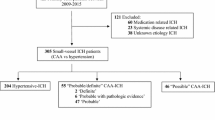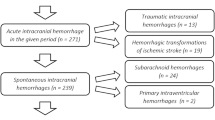Abstract
Background
Anticoagulation increases the risk of intracerebral hemorrhage (ICH), yet whether different underlying disease processes are equally affected is unknown. We tested the hypothesis that coagulopathy, measured by admission international normalized ratio (INR), disproportionately increases the risk for lobar hemorrhages.
Methods
Patients with primary ICH were enrolled into a registry between December 2006 and February 2012 with prospective data acquisition and systematic follow up. Logistic regression was used to test whether lobar versus deep ICH location was independently associated with INR, and then whether INR had an influence on mortality. Spearman’s correlation coefficient was used to test for an association between INR and hematoma volume separately in the lobar and deep ICH groups.
Results
221 patients were studied. Patients with lobar ICH were older (71 vs. 62 years old, p < 0.001) and more likely to have prior ICH (10 vs. 0 %, p < 0.001). INR >1.4 was observed on admission more frequently in lobar versus deep ICH (19 vs. 8 %, p = 0.02). Lobar ICH location was independently associated with INR >1.4 (OR: 2.51, 95 % CI: 1.03–6.14, p = 0.043). ICH volume correlated with INR in lobar ICH (p = 0.009), but not deep ICH (p = 0.8). Death at 1 month was independently associated with INR >1.4 (OR: 7.6, 95 % CI: 2.4–24.1, p = 0.001) after correction for the ICH Score.
Conclusions
Abnormal coagulation occurs disproportionally in lobar versus deep ICH, and is associated with larger ICH volumes and higher mortality. These findings suggest a unique risk interaction between coagulopathy and underlying brain pathology due to cerebral amyloid angiopathy.
Similar content being viewed by others
References
Flaherty ML, Kissela B, Woo D, et al. The increasing incidence of anticoagulant-associated intracerebral hemorrhage. Neurology. 2007;68:116–21.
Rosand J, Eckman MH, Knudsen KA, Singer DE, Greenberg SM. The effect of warfarin and intensity of anticoagulation on outcome of intracerebral hemorrhage. Arch Intern Med. 2004;164:880–4.
Hart RG. What causes intracerebral hemorrhage during warfarin therapy? Neurology. 2000;55:907–8.
Hemphill JC III, Bonovich DC, Besmertis L, Manley GT, Johnston SC. The ICH Score: a simple, reliable grading scale for intracerebral hemorrhage. Stroke. 2001;32:891–7.
Hemphill JC III, Farrant M, Neill TA Jr. Prospective validation of the ICH Score for 12-month functional outcome. Neurology. 2009;73:1088–94.
Flibotte JJ, Hagan N, O’Donnell J, Greenberg SM, Rosand J. Warfarin, hematoma expansion, and outcome of intracerebral hemorrhage. Neurology. 2004;63:1059–64.
Flaherty ML, Haverbusch M, Sekar P, et al. Location and outcome of anticoagulant-associated intracerebral hemorrhage. Neurocrit Care. 2006;5:197–201.
Lee SH, Ryu WS, Roh JK. Cerebral microbleeds are a risk factor for warfarin-related intracerebral hemorrhage. Neurology. 2009;72:171–6.
Poels MM, Ikram MA, van der Lugt A, et al. Incidence of cerebral microbleeds in the general population: the Rotterdam scan study. Stroke. 2011;42:656–61.
Weller RO, Massey A, Newman TA, Hutchings M, Kuo YM, Roher AE. Cerebral amyloid angiopathy: amyloid beta accumulates in putative interstitial fluid drainage pathways in Alzheimer’s disease. Am J Pathol. 1998;153:725–33.
Vonsattel JP, Myers RH, Hedley-Whyte ET, Ropper AH, Bird ED, Richardson EP Jr. Cerebral amyloid angiopathy without and with cerebral hemorrhages: a comparative histological study. Ann Neurol. 1991;30:637–49.
Rosand J, Hylek EM, O’Donnell HC, Greenberg SM. Warfarin-associated hemorrhage and cerebral amyloid angiopathy: a genetic and pathologic study. Neurology. 2000;55:947–51.
Eckman MH, Wong LK, Soo YO, et al. Patient-specific decision-making for warfarin therapy in nonvalvular atrial fibrillation: how will screening with genetics and imaging help? Stroke. 2008;39:3308–15.
Conflict of interest
None.
Source of Funding
Departmentally funded.
Author information
Authors and Affiliations
Corresponding author
Rights and permissions
About this article
Cite this article
Maas, M.B., Rosenberg, N.F., Kosteva, A.R. et al. Coagulopathy Disproportionately Predisposes to Lobar Intracerebral Hemorrhage. Neurocrit Care 18, 166–169 (2013). https://doi.org/10.1007/s12028-012-9814-x
Published:
Issue Date:
DOI: https://doi.org/10.1007/s12028-012-9814-x




